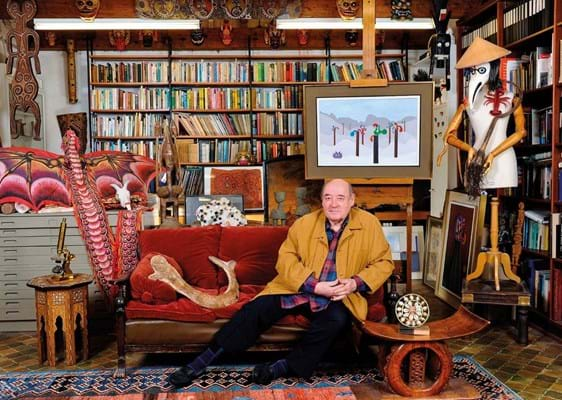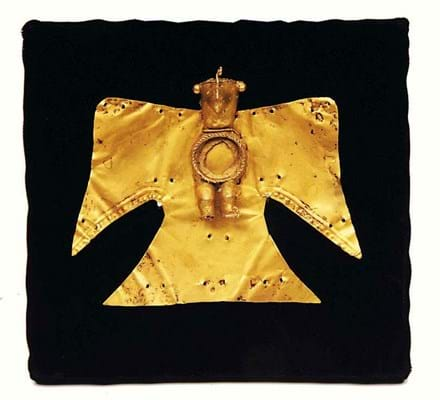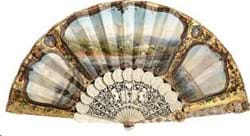Scientist and Surrealist painter Desmond Morris is best known for his work as a TV zoologist and his best-selling book The Naked Ape (1967) about the results of sexual selection and evolution in the human species.
However he also identifies with the Surrealist art movement and now calls himself “the last living Surrealist”. He has been a collector and artist since his childhood.
In April he sold a collection of his own art at Mallams and on June 19 the Oxfordshire auction house will offer Morris’ collection of Pre-Columbian art and books on the subject in its Oxford Library sale. He is also selling a large part of his collection at Bonhams' Antiquities sale on July 3 in Bond Street.
Now 91, he splits his time between painting and writing.
In the latest of our occasional series of collector interviews, ATG hears from Morris on his life as a collector and artist.
ATG: When did you first paint?
Desmond Morris: When I was at boarding school in Wiltshire during the Second World War.
How were you first inspired by the Surrealist movement?
I was so horrified by the slaughter of the war that I rebelled against adult society and looked for something outrageous. I discovered the Surrealists, who had reacted to the slaughter of the First World War by creating works that were an assault on the traditional arts.
Like them, I wanted to rebel against the establishment, but creatively rather than destructively. I have been painting Surrealist pictures for the past 75 years and have completed over 3000 works.
What art do you collect and why?
As a child I began collecting fossil and minerals. Then, as a teenager I began collecting tribal art that could, at that time, be found in junk shops. I loved the fact that tribal artists, like the Surrealists, had no respect for precise copying of the external world.
Later on, when I had some money, I started collecting ancient art. Again, I was delighted to find that ancient artists hardly ever created works that imitated nature.
They, like the tribal artists, created invented shapes, using their imagination, rather than trying to copy the external world.
Does your collection inspire your own painting?
Yes, many of the shapes I find in ancient art have the same kinds of exaggerations and distortions that I find in Surrealist art.
How have your collecting habits changed over the years?
I have gone through many phases – postage stamps as a small boy, then fossils and minerals, then seashells, then tribal art, then Modern art, then ancient Cypriot art, then Russian icons, then Pre-Columbian art, then Chinese art, and finally Algerian Berber pottery.
How do you display your collection?
It is important to have it all around you and not shut away in cupboards.
I have been lucky because I have, for half a century, lived in a large Victorian house in north Oxford when I could have many display cases and shelves, where I could visibly surround myself by my collections.
“Never buy a routine piece simply because it belongs to a category in which you are interested – each piece must sing to you
Is there one item you are still trying to find?
One is always on the look-out for something exciting that cannot be resisted. Often, when a single special item is acquired this then sets off a search for more and a whole new collection begins.
Why are you selling part of your collection? Or are you selling all of it?
I have often sold pieces in the past so that I can move on to other areas and explore new forms of art. Some collectors never sell anything, but I am not like that.
When I wrote my book on The Art of Ancient Cyprus I had fulfilled my study of that genre and sold my 1100 Cypriot pieces in London. I then started collecting Pre-Columbian art.
The reason I am now selling off much of my collections is that, following the death of my wife, I am leaving England and going to live near my family in Ireland.
My new house there is much smaller than my present one and I have had to downsize my collections, taking only a few favourite pieces with me.
What is the most you have ever spent on an item?
A few thousand. I would rather have a hundred less valuable pieces, that I can compare with one another, rather than just a few very expensive pieces.
What tips would you give to would-be collectors?
Buy only the piece that catches your eye and is somehow special. Never buy a routine piece simply because it belongs to a category in which you are interested. Each piece must sing to you.
Where do you buy and where have you bought before?
I have bought almost all my pieces from Sotheby’s and Christie’s in London.
When I was building my collections of ancient and tribal art, I attended every auction sale in London in person. But I have also bought some pieces from art galleries and dealers in New York, Amsterdam, Paris, Lisbon and London.
What would you like to be remembered for: as an author and zoologist or as an artist?
I would like to be remembered as the only person ever to have had both a book in the top hundred best-sellers of all time and a painting in the Tate.
It is this unique combination that is important to me and the fact that I have been able to live a double life!


















